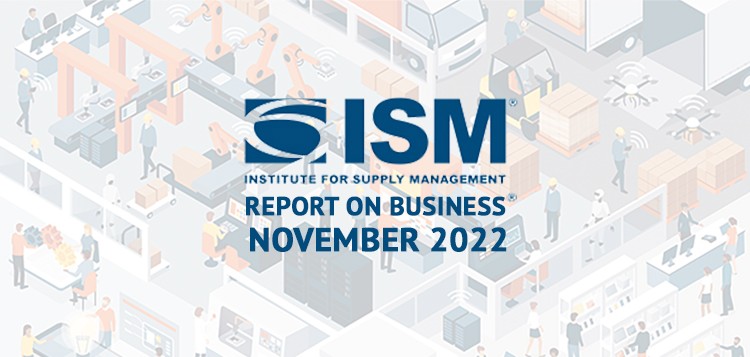The Manufacturing Economy is Officially in Contraction

After a 12-month slide, manufacturing has officially fallen into contraction territory — at least, according to the November 2022 Manufacturing ISM® Report On Business®. With a 1.2-point pullback, the industry benchmark for growth of the manufacturing economy has settled at 49, representing contraction after 29 consecutive months of growth. It’s the lowest point since May 2020.
Manufacturing, by the numbers
Findings from the November 2022 Manufacturing ISM® report confirm what many manufacturers (and economists) have monitored for months: The manufacturing economy is contracting, with business softening across nearly every key sector.
New Orders slipped to a low of 47.2, down 2 points from October, followed by a drop of 0.8 points in Production. Employment figures tipped down 1.2 points after previously bouncing around in expansion territory. Meanwhile, Customers’ Inventories skyrocketed 7.1 points, signaling stockpiling tendencies that coincide with recession fears. Order Backlogs also dropped 5.3 points, alongside Imports, which sunk 4.2 points.
Ultimately, November’s report represents the official reversal from expansion to contraction — and it begins what many analysts believe could be a pullback that prevails through the upcoming year.

Contraction as a sign of what’s to come
The November ISM® report provides clear-cut evidence of contraction in the manufacturing space. While that doesn’t necessarily mean the country is in recession, it’s a sign we’re trending in that direction. Eight of 10 PMI metrics are in contraction, signaling broad downturn that goes beyond manufacturing.
Economists have long recognized manufacturing as the front line of the economy. Contraction and recession traditionally strike manufacturing first, both exacerbating other economic stressors and creating new catalysts for broader economic downturn. Manufacturing contraction is here; economic recession is likely to follow.
Recession has already hit Europe in 2022. The same markers of recession could soon hit U.S. shores — as early as Q1 of 2023. Moreover, the extent of the contraction could be significant. According to Bank of America’s industry analysts, “In our 10/4/22 note, we argued that PMI could fall to around 35. This would be lower than the 39 average trough over the last four US recessions.”

The outlook: Economic uncertainty
While the manufacturing industry shows signs of recession, the picture isn’t entirely grim. The November 2022 Services ISM® Report On Business® — the service-based counterpart to the Manufacturing PMI — rose 2.1 points in November. The service-sector PMI has shown resilience, coming in at a stable at 56.5 … for now.
In any case, it’s clear there’s an economic slowdown on the horizon, and manufacturers need to prepare for the hardships that may lie ahead. Many are already taking evasive action. And while it’s virtually impossible to classify a recession until it’s truly underway, it seems a good bet we’ll soon be able to call it what it is — at least, from a manufacturing standpoint.